|
|
|
|
|
|
THE unique international and diverse nature of the Benedictine Congregation of the Annunciation is due in large part to the vision and aspirations of Gerard Van Caloen, the founder of Sint Andries, Zevenkerken. Almost exactly one hundred years ago Gerard Van Caloen confided to his superiors his dream that the ancient tradition of monastic missionaries might be one day be revived. The living out of this dream resulted in the foundation of monasteries in Africa, India, China, Poland, Ireland, and finally, California.
|
|
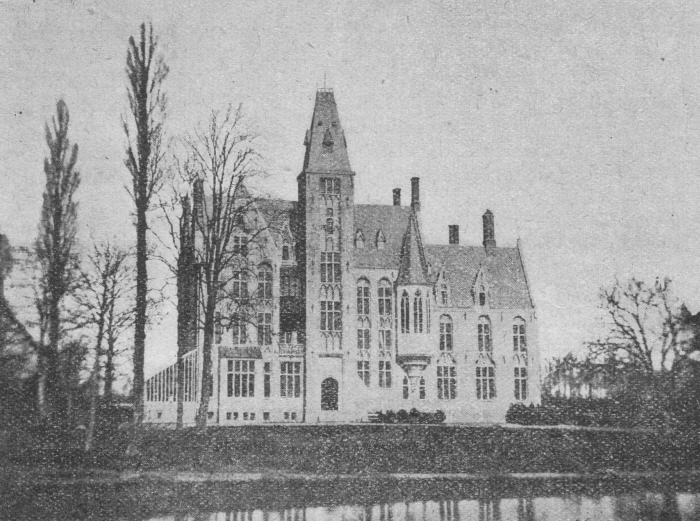 |
| Baron Karl Van Caloen and his wife Sabina, Countess of Gourcy-Serainchamps | The Van Caloen Chateau, Lophem, Bruggs |
JOSEPH Van Caloen was born in Bruges in 1853, the son of Baron Karl Van Caloen and his wife Sabina, Countess of Gourcy-Serainchamps.
|
|
|
|
Young Baron Joseph Van Caloen and his tutor, Fr. Daemers |
Br. Gerard, Junior Benedictine monk |
Like Andreas Amrhein, his future friend and fellow Benedictine missionary-founder, he was a frail child, and was taught at home in the Van Caloen's ancestral castle in Lophem, on the outskirts of Bruges.
|
|
|
| POPE PIUS IX | BEURON ARCHABBEY, Baden-Wurtenberg, GERMANY |
His family was deeply religious; and in 1873 with the permission of his parents and the personal blessing of Pope Pius IX young Joseph was clothed as a novice at the Archabbey of Beuron in Germany which had been founded ten years earlier by Placid and Maurus Wolter.
|
|
|
| ARCHABBOT MAURUS WOLTER | DESCLEE CHATEAU, MAREDRET |
ARCHABBOT Maurus Wolter was particularly interested in his noble Flemish novice. The monks of Beuron had already planned the foundation of a daughter-house in Belgium: the young baron’s family represented valuable links with the Belgian aristocracy and government; and Joseph seemed providentially sent to become part of the new foundation. He spent his six-month postulancy in the Desclee castle at Maredret, where a small group from Beuron awaited completion of the Priory of Maredsous.
|
|
|
|
MAREDSOUS |
ABBEY |
AT the end of his postulancy Joseph was sent to Beuron to begin his novitiate, where on the Feast of Christ the King he was clothed and given the monastic name “Gerard”. His novicemaster was the second pillar of Beuron, Placidus Wolter.
|
|
|
|
BEURON ABBEY |
Abbot Placid Wolter |
BR. Gerard was afflicted with a weak constitution: a severe respiratory infection in the fall caused his parents and superiors to wonder whether the rigors of a winter in the Danube Valley would prove too much for him. One is tempted to wonder whether the rigors of a novitiate under the formidable Dom Placidus would not have presented an obstacle to Gerard's vocation even in the absence of a severe climate;1 but in any case another solution was found. It was eventually decided to send him to the French Riviera with a similarly-afflicted fellow novice and an ad hoc novicemaster. His novitiate was thus completed in the company of two other monks from Beuron in a villa owned by a community of nuns. Br. Gerard returned to Beuron to profess vows on May 25, 1874.
ANTI -Catholic legislation in Germany (the so-called “Kulturkampf”) resulted in a large portion of the community at Beuron being sent into exile. Br. Gerard was sent to Maredsous in the company of the newly-named superior of that monastery, Placidus Wolter. Br. Gerard was ordained priest on December 23, 1876, and his superiors lost no time in granting him scope to exercise his talents. Although he was only twenty-three years old, he was appointed novicemaster and prior of Maredsous the day after his priestly ordination. It rapidly became clear, however, that the young prior’s imagination and zeal for new projects were not matched by either the patience or the ability necessary to see these projects to completion. Either his health would break down, or he would busy himself with so many schemes that none would receive the full attention it required.
|
|
|
|
MAREDSOUS, 1920 |
Dom Placidus Wolter |
IN 1878 Maredsous was raised to abbatial dignity; and Placidus Wolter, the new abbot, promptly relieved Van Caloen of the “burden” of the office of prior. Six months later he was similarly relieved of responsibility for the novices and was placed in charge of the monastery library.
VAN Caloen then devoted his energies to an apostolate of literary activity and teaching. In 1882 he published a comprehensive missal and explanation of the liturgy similar to Gueranger’s L’Annee Liturgique but on a smaller scale, Missel des Fidèles, the first French-Latin missal for the laity. which became immensely popular. The following year he aroused controversy by recommending at a conference in Liege that the faithful receive communion during mass, rather than before or after the celebration (La communion des fidèles pendant la messe, Mémoire présenté au Congrès eucharistique de Liège, Luik, Lefort, 1883 / Lille, Desclée de Brouwer, 1884).
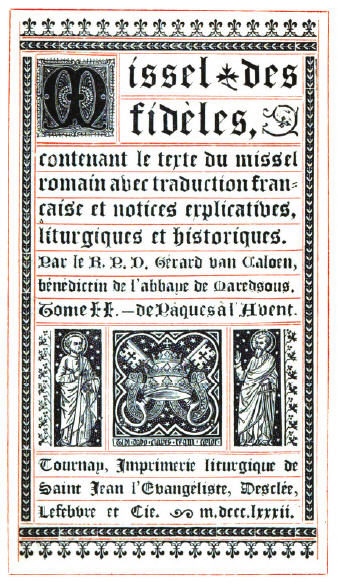 |
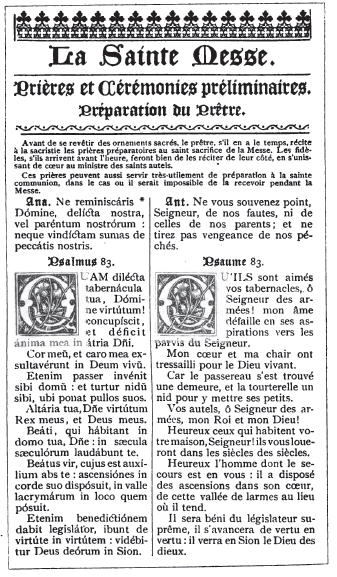 |
|
IN 1884 he founded a periodical, Messager des Fideles, which in 1890 became Revue Benedictine. Through his initiative a small school was opened at Maredsous in 1881, and from 1882-1886 he served as its first rector.2
IT was as rector of the school at Maredsous that Van Caloen first broached with his superiors the subject of missionary activity. In 1885 he proposed to Abbot Placidus the project of opening in conjunction with the school at Maredsous a missionary institute where gifted children could be trained to serve as Benedictine missionaries in the Belgian Congo. In 1880 King Leopold II had appealed to the religious of Belgium to assist in the work of transforming the Congo into a Belgian colony. Van Caloen’s idea received the initial support of the king and the Belgian Minister for Foreign Affairs; however before definitive steps could be taken toward its completion, Van Caloen was named Procurator General for the Beuronese Congregation by his superiors, and was sent to Rome.
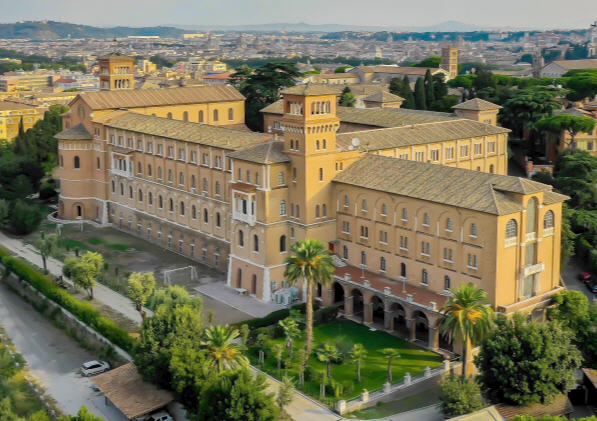 |
|
|
SANT' ANSELMO (Aventine, Rome) |
SANT' ANSELMO Church Interior |
FROM 1886 to 1888 Van Caloen served his congregation as procurator in Rome. He also participated in the establishment of the Benedictine College of Sant’ Anselmo on the Aventine, where he became master of clerics and professor of liturgy. Thus he came to the attention of Pope Leo XIII who had hoped that the reestablishment of Sant’ Anselmo would help to unify the Benedictine congregations. During this period Van Caloen acquired an additional interest: namely, ecumenical dialogue with representatives of the Greek and Russian Orthodox Churches.
HIS interest in Benedictine missionary activity also increased during these two years. At Maredsous he had come into contact with Andreas Amrhein, the later founder of the Benedictine Missionary Congregation of St. Ottilien: it is possible that the two of them had exchanged views at that time on the subject of Benedictines serving as missionaries. In his capacity as procurator Van Caloen again came into contact with Amrhein during the latter’s efforts to obtain Roman ratification of his newly-founded mission society. In a meeting in late April or eary May of 1887 Van Caloen expressed his hope that the Beuronese Congregation might in some way be able to support Amrhein in his missionary ventures.
CERTAINLY Van Caloen’s missionary aspirations ripened during these two years in Rome; for on his return to Maredsous for the consecration of the abbey church in 1888 he shared with his superiors his hope that the “ancient Benedictine missionary tradition might be restored.” He proposed the foundation of an “apostolic monastery” in which missionary activity as well as the liturgical and “oriental” (ecumenism with the Eastern Churches) apostolates could be supported. Abbot Placidus responded by entrusting to Van Caloen the responsibility to go to Louvain and there assist in the development of a monastic house of studies at the university.
|
|
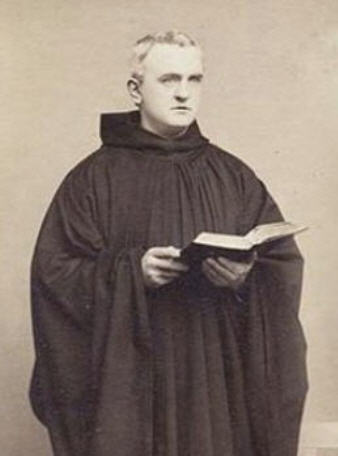 |
| MONT CESAR (KAIZERBERG) Abbey in Louvain | Hildebrand de Hemptine |
FOR four years Van Caloen both worked with university students as a chaplain and began the initial planning for a monastic foundation from Maredsous to be made in Louvain. He shared with both his Abbot and his personal friend and confrere, Hildebrand De Hemptinne, his hopes that this new foundation might be directed towards the training of monastic missionaries. He was sent back to Rome as Beuronese Procurator in 1893.
|
|
|
|
| Abbot Domingos Machado | Pope Leo XIII | Gerard VanCaloen |
IN Rome he at last discovered a possible means of realizing his dream of monastic mission. The Brazilian Benedictine Congregation had been slowly dying as a result of anticlerical legislation enacted in 1827, which forbade the Brazilian monasteries to accept novices. A change in government policy in 1889 reversed the earlier prohibitions and offered the possibility of a monastic revival. Thus the Abbot President of the Brazilian Congregation, Domingos Machado, appealed to Pope Leo XIII for help, asking him to solicit the aid of one of the European Benedictine congregations. In a papal audience on August 29, 1893 Van Caloen suggested that the Beuronese Congregation might undertake this task; indeed, he showed such enthusiasm for the project that the pope exclaimed:
Ibis in Brasiliam. Laborabis ibi pro Ecclesia et pro Ordine S. Benedicti. Est mea voluntas!
You shall go there - to Brazil. You will labor there for the Church and for the Order of St. Benedict. It is my will!
PLACIDUS Wolter had by this time left Maredsous to become the second Archabbot of Beuron. He agreed to aid in the work of monastic restoration, and sent Van Caloen with a second monk, Jerome Kiene, to evaluate the situation in Brazil. They arrived in early 1894, and were able to return to Europe in July to report their findings to the General Chapter of the Beuronese Congregation which convened at Maredsous.
|
|
|
|
St. Benedict, Rio, Interior |
St. Benedict, Rio |
THE
Chapter agreed to undertake the project, and Van Caloen was entrusted with responsibility for its implementation in July of 1895. In order to facilitate Van Caloen’s efforts, Leo XIII drafted an “Apostolic Letter to the Belgian Nation” in which he commended the work of monastic restoration and encouraged the Belgians to support it.|
|
| Braz-abbey_O-L_Montserrat_Rio_f-1589 Mosteiro de São Bento (Monastery of St. Benedict) |
|
|
| Braz-abbey_St_Benedict_Olinda_f-1640 |
|
|
| Braz-abbey_St_Sebastian_Bahia_f-1581 |
VAN Caloen transferred his monastic stability to the Brazilian Congregation, and was elected Abbot of the monastery of Olinda eight months after arriving in Brazil. In addition to the task of restoring monastic life in the Brazilian abbeys, Van Caloen became convinced that it was necessary for the monks to undertake missionary work.
|
|
|
|
Rio Branco, Amazon |
Amazonian Mission |
On December 19, 1898, Pope Leo XIII published an apostolic letter in which he designating Van Caloen’s work as principally concerned with missionary work among the Indians of the Amazon.
|
|
| THE ORIGINAL PROCURA of St.ANDRE (training center for monks for Brazil) |
IN order to facilitate the work in Brazil, the abbey of Beuron had in 1898 authorized the foundation of the Missionary Procura of St. Andre in Bruges. This school for the work in Brazil was created through the generosity of Gerard Van Caloen’s family near their home in Lophem.
In 1901 the Procura of St. André was elevated to the status of an abbey and designated a monastery “for the missions”. It was accorded all the rights and privileges of a Beuronese monastery; however it was completely independent of Beuron and was eventually affiliated to the Brazilian Congregation, with Van Caloen its first superior.
|
|
|
|
SINT ANDRIES, ZEVENKERKEN, |
formerly ST. ANDRÉ, BRUGGE |
G
ERARD Van Caloen’s responsibilities progressively increased: he was made Abbot President of the Brazilian Congregation in 1900; and was named ordinary (titular bishop) of the Brazilian mission district of Rio Branco in 1907. With the help of monks from abbeys all over Europe, and especially from the Congregation of Beuron, the Brazilian monasteries of Bahia, Olinda, and Rio de Janeiro began to recover their former vitality.|
|
|
| Y | T |
In 1908 Van Caloen became Abbot President of the Brazilian Congregation, and the twofold work of monastic restoration and missionary work continued under his guidance. Tensions arose both from his administrative style (he found it difficult to share authority) and from increasing financial difficulties of the Brazilian Congregation. Although Abbot Michael Kruse requested a canonical visitation by the Abbot Primate in 1910, this request was effectively deflected by Abbot Primate De Hemptinne, who recommended instead that the Brazilian General Chapter meet in Rome: “The time is not yet ripe for a visitation by me [in Brazil j.” (Letter: De Hemptinne to Kruse, 10. Jan., 1910: Archives of Sant’ Anselmo).
In 1915, however, a variety of crises prompted his withdrawal from all administrative responsibilities except his work in the mission district of Rio Branco on the Amazon.
In 1919 a breakdown in health necessitated Bishop Van Caloen’s return to Europe for the last time. He would never again return to his beloved Brazil.
H
E lived for a brief time at the abbey of St. Andre, and was to some extent involved in the canonical erection of the Congregation of the Annunciation in 1920.|
|
|
| BYZANTINE RITE CHAPEL in NICE, FRANCS | BISHOP VAN CALOEN |
Unable to tolerate the weather of his homeland, he was compelled to retire to a more pleasant climate in the south of France, where he lived until his death in 1932. These last years of his life were spent in writing and in active work on behalf of Roman Catholic-Orthodox ecumenism.
THE vision and dream of Gerard Van Caloen, Bishop, Abbot, monastic founder, and missionary, were carried forward by his successor at St. Andre, Abbot Theodore Neve. The monks of St. Andre undertook missionary responsibilities in Africa and China, and restored monastic life in Poland.
1 Placidus Wolter was evidently afflicted with a melancholic temperament: Blessed Columbia Marmion later recounted that on the eve of his monastic profession he began to thank (then Abbot) Placidus for the graces he was to receive, but was interrupted with the caustic observation, "That is enough! As for your profession I am quite sad about it." (Thibaut, p.67).
2 A legend still current in the oral tradition of the Abbeys of Maredsous and St. Andre (now Sint Andriesabdij, Zevenkerken) portrays Van Caloen as having established the school as prior during one of Placidus Wolter’s absences from Maredsous. According to the story, Van Caloen was removed as prior and made rector as a penance for having acted without his superior’s permission. The details of this legend are contradicted by the fact that Van Caloen was removed as prior in 1878, whereas the school was not opened until 1881.
Gaspar Lefebvre, a close friend and admirer of Van Caloen, took pains in his biographical article to portray his friend and former superior as a model monk, obedient in all respects. He transmitted uncritically the contention made by Van Caloen in his memoirs that Abbot Placidus had commanded him to open the school (Lefebvre, p.26). That the reality probably lies somewhere between the legend and Van Caloen’s later claim is suggested in Ghesquiere’s article. Theodore Ghesquiere was less personally devoted to Van Caloen than Lefebvre: he admitted frankly that the school was opened “at his [Van Caloen’s initiative” (Ghesquiere p. 201); but as abbot of St. Andre, the monastery founded by Van Caloen, Ghesquiere discretely refrained from expanding on details.
|
|
|
| Y | T |
Adapted
from The Benedictine Missionary Movement, Luke Dysinger,
O.S.B.,
© copyright St. Andrew's Abbey, Valyermo,
1990.
This Webpage was created for a workshop held at Saint Andrew's Abbey, Valyermo, California in 1990